Ozito ROU-5000U Handleiding
Ozito
Niet gecategoriseerd
ROU-5000U
Bekijk gratis de handleiding van Ozito ROU-5000U (3 pagina’s), behorend tot de categorie Niet gecategoriseerd. Deze gids werd als nuttig beoordeeld door 42 mensen en kreeg gemiddeld 5.0 sterren uit 21.5 reviews. Heb je een vraag over Ozito ROU-5000U of wil je andere gebruikers van dit product iets vragen? Stel een vraag
Pagina 1/3

ROUTER
850W
ORIGINAL INSTRUCTIONS
SPECIFICATIONS
Voltage: 230-240V ~ 50Hz
Input: 850W
No Load Speed: 11,500-30,000/min
Collet Size: 6.35mm (1/4”)
Plunge Depth: 30mm
Turret Stops: 3
Weight: 3.1kg
ROU-5000U
WHAT’S IN THE BOX
Router
MAINTENANCE
DESCRIPTION OF SYMBOLS
TROUBLESHOOTING
• Keep the ventilation vents of the router clean at all times, if possible, prevent
foreign matter from entering the vents.
• After each use, blow air through the router housing to ensure it is free from
all dust particles which may build up. Build up of dust particles may cause the
router to overheat and fail.
• If the enclosure of the router requires cleaning, do not use solvents but a
moist soft cloth only. Never let any liquid get inside the router; never immerse
any part of the router into a liquid.
Carbon Brushes
When the carbon brushes wear out, the router will spark and/or stop.
Discontinue use as soon as this happens. They should be replaced prior to
recommencing use of the router. Carbon brushes are a wearing component of
the router therefore not covered under warranty. Continuing to use the router
when carbon brushes need to be replaced may cause permanent damage to
the router. Carbon brushes will wear out after many uses but when the carbon
brushes need to be replaced, take the router to an
electrician or a power tool repairer for a quick and
low cost replacement. Always replace both carbon
brushes at the same time.
Note: Ozito Industries will not be responsible for any
damage or injuries caused by the repair of the router
by an unauthorised person or by mishandling of the
router.
SPARE PARTS
ozito-diy.co.uk
ROUTER SAFETY WARNINGS
WARNING! When using mains-powered tools, basic safety precautions, including the
following, should always be followed to reduce risk of re, electric shock, personal injury
and material damage.
Read the whole manual carefully and make sure you know how to switch the tool off in an emergency, before
operating the tool.
Save these instructions and other documents supplied with this tool for future reference.
Before you connect the equipment to the mains supply make sure that the data on the rating plate are
identical to the mains data.
This tool is double insulated therefore no earth wire is required.
If the supply cord is damaged, it must be replaced by an electrician or a power tool repairer in order to avoid
a hazard.
Note: Double insulation does not take the place of normal safety precautions when operating this tool. The
insulation system is for added protection against injury resulting from a possible electrical insulation failure
within the tool.
Using an Extension Lead
Always use an approved extension lead suitable for the power input of this tool. Before use, inspect the
extension lead for signs of damage, wear and ageing. Replace the extension lead if damaged or defective.
When using an extension lead on a reel, always unwind the lead completely. Use of an extension lead not
suitable for the power input of the tool or which is damaged or defective may result in a risk of re and electric
shock.
WARNING! Read all safety warnings and all instructions. Failure to follow the warnings and
instructions may result in electric shock, re and/or serious injury.
Save all warnings and instructions for future reference. The term “power tool” in the
warnings refers to your mains-operated (corded) power tool or battery-operated (cordless) power
tool.
1. Work area safety
a. Keep work area clean and well lit. Cluttered or dark areas invite accidents.
b. Do not operate power tools in explosive atmospheres, such as in the presence of ammable
liquids, gases or dust. Power tools create sparks which may ignite the dust or fumes.
c. Keep children and bystanders away while operating a power tool. Distractions can cause you to
lose control.
2. Electrical safety
a. Power tool plugs must match the outlet. Never modify the plug in any way. Do not use any
adapter plugs with earthed (grounded) power tools. Unmodied plugs and matching outlets will
reduce risk of electric shock.
b. Avoid body contact with earthed or grounded surfaces, such as pipes, radiators, ranges and
refrigerators. There is an increased risk of electric shock if your body is earthed or grounded.
c. Do not expose power tools to rain or wet conditions. Water entering a power tool will increase the
risk of electric shock.
d. Do not abuse the cord. Never use the cord for carrying, pulling or unplugging the power tool.
Keep cord away from heat, oil, sharp edges or moving parts. Damaged or entangled cords increase
the risk of electric shock.
e. When operating a power tool outdoors, use an extension cord suitable for outdoor use. Use of a
cord suitable for outdoor use reduces the risk of electric shock.
f. If operating a power tool in a damp location is unavoidable, use a residual current device (RCD)
protected supply. Use of an RCD reduces the risk of electric shock.
3. Personal safety
a. Stay alert, watch what you are doing and use common sense when operating a power tool. Do
not use a power tool while you are tired or under the inuence of drugs, alcohol or medication. A
moment of inattention while operating power tools may result in serious personal injury.
b. Use personal protective equipment. Always wear eye protection. Protective equipment such as dust
mask, non-skid safety shoes, hard hat, or hearing protection used for appropriate conditions will reduce
personal injuries.
c. Prevent unintentional starting. Ensure the switch is in the off-position before connecting to
power source and/or battery pack, picking up or carrying the tool. Carrying power tools with your
nger on the switch or energising power tools that have the switch on invites accidents.
d. Remove any adjusting key or wrench before turning the power tool on. A wrench or a key left
attached to a rotating part of the power tool may result in personal injury.
e. Do not overreach. Keep proper footing and balance at all times. This enables better control of the
power tool in unexpected situations.
f. Dress properly. Do not wear loose clothing or jewellery. Keep your hair, clothing and gloves away
from moving parts. Loose clothes, jewellery or long hair can be caught in moving parts.
g. If devices are provided for the connection of dust extraction and collection facilities, ensure
these are connected and properly used. Use of dust collection can reduce dust-related hazards.
4. Power tool use and care
a. Do not force the power tool. Use the correct power tool for your application. The correct power tool
will do the job better and safer at the rate for which it was designed.
b. Do not use the power tool if the switch does not turn it on and off. Any power tool that cannot be
controlled with the switch is dangerous and must be repaired.
c. Disconnect the plug from the power source and/or the battery pack from the power tool before
making any adjustments, changing accessories, or storing power tools. Such preventive safety
measures reduce the risk of starting the power tool accidentally.
d. Store idle power tools out of the reach of children and do not allow persons unfamiliar with the
power tool or these instructions to operate the power tool. Power tools are dangerous in the hands
of untrained users.
e. Maintain power tools. Check for misalignment or binding of moving parts, breakage of parts and
any other condition that may affect the power tool’s operation. If damaged, have the power tool
repaired before use. Many accidents are caused by poorly maintained power tools.
f. Keep cutting tools sharp and clean. Properly maintained cutting tools with sharp cutting edges are
less likely to bind and are easier to control.
g. Use the power tool, accessories and tool bits etc. in accordance with these instructions, taking
into account the working conditions and the work to be performed. Use of the power tool for
operations different from those intended could result in a hazardous situation.
5. Service
a. Have your power tool serviced by a qualied repair person using only identical replacement
parts. This will ensure that the safety of the power tool is maintained.
GENERAL POWER TOOL SAFETY WARNINGS
ELECTRICAL SAFETY
SYMPTOM POSSIBLE CAUSE REMEDY
Router will not
operate No supply of power Check that power is
available at source
Router runs slowly
Blunt or damaged
router bits
Re-sharpen or replace
router bits
Variable speed set low Increase variable speed
setting
Motor is overloaded Reduce excessive load
or force on router
Excessive vibration Bent router bit shaft Replace router bit
Sparking visible
through the
housing vents
This is normal and
does not indicate a
problem
No action is required
Heavy sparking
occurs inside motor
housing
Brushes not moving
freely
Disconnect power,
remove brushes, clean
or replace
WARNING! This appliance is not intended for use by persons (including children) with
reduced physical, sensory or mental capabilities, or lack of experience and knowledge,
unless they have been given supervision or instruction concerning use of the appliance by
a person responsible for their safety.
Recommendations for the use of a residual current device (RCD) with a rated residual current
of 30mA or less.
Hold power tool by insulated gripping surface, because the cutter may contact its own cord.
Cutting a “live” wire may make exposed metal parts of the power tool “live” and shock the operator.
Use clamps or another practical way to secure and support the workpiece to a stable
platform. Holding the work by hand or against the body leaves it unstable and may lead to loss of
control.
Using an Extension Lead
Always use an approved extension lead suitable for the power input of this tool. Before use, inspect
the extension lead for signs of damage, wear and ageing. Replace the extension lead if damaged
or defective.
When using an extension lead on a reel, always unwind the lead completely. Use of an extension
lead not suitable for the power input of the tool or which is damaged of defective may result in a risk
of re and electric shock.
It is recommended that the extension lead is a maximum of 25m in length. Do not use multiple
extension leads.
• Wear safety glasses or goggles when operating this tool.
• Only use router bits with a shank diameter equal to the size of the collet installed in the tool.
• Only use router bits suitable for the no-load speed of the tool.
• Do not use the tool in an inverted position.
• Do not attempt to use the tool in a stationary mode.
• Take special care when routing MDF or surfaces coated with lead-based paint.
• Wear a dust mask specically designed for protection against lead paint dust and fumes and
ensure that persons within or entering the work area are also protected.
• Do not let children or pregnant women enter the work area.
• Do not eat, drink or smoke in the work area.
• Dispose of dust particles and any other debris safely.
Guide Fence
Dust Extraction
Adaptor
Template Guide
V GROOVE BITS
Used to create V shaped
channels or utes in a
workpiece.
ROUTER BITS
Below is a list of common router bits and their uses.
FLUSH TRIM BITS
Suited to trimming the
edge of one piece ush
with the edge of another
piece. A common use
is using a pattern or
template to create
multiple identical shapes
of the pattern.
ROUND NOSE BITS
Similar to the V-groove
bit in that it creates
channels or utes in a
workpiece.
DOVE TAIL
Most commonly used to
create tails for dovetail
joinery. Plunge cuts a
at bottom with angled
sides into a workpiece.
CHAMFER
Cuts a 45-degree
angle on a square
edge.
COVE BIT
Used to create a
concave, rounded
edge to a piece of
timber. Often used in
conjunction with a round
over bit.
ROUND OVER BIT
Creates a rounded edge
on a piece.
STRAIGHT BITS
Straight router bits a ideal
for making plunge cuts into
a material to form a groove
or to hollow out an area for
a mortise or inlay.
WARRANTY
OZITO UK Unit 9 Stadium Court, Wirral International Business Park, Plantation Road, Bromborough, Wirral, CH62 3QG 0716
All of our products undergo strict quality checks to ensure that they reach
you in perfect condition. In the unlikely event that your device develops a
fault, please contact our service department at the address shown on this
guarantee card. You can also contact us by telephone using the customer
service number shown. Please note the following terms under which
guarantee claims can be made:
1. These warranty terms regulate additional warranty services, which the
manufacturer mentioned below promises to buyers of its new products
in addition to their statutory guarantee claims are not affected by this
guarantee. Our guarantee is free of charge to you.
2. The warranty services only covers defects due to material or
manufacturing faults on a product which you have bought from the
manufacturer mentioned below are limited to either the rectication of said
defects on the product or the replacement of the product, whichever we
prefer.
Please note that our devices are not designed for use in commercial, trade
or professional applications. A guarantee contract will not be created if the
device has been used by commercial, trade or industrial business or has
been exposed to similar stresses during the guarantee period.
3. The following are not covered by our guarantee:
- Damage to the device caused by a failure to follow the assembly
instructions or due to incorrect installation, a failure to follow the operating
instructions (for example connecting it to an incorrect mains voltage or
current type) or a failure to follow the maintenance and safety instructions
or by exposing the device to abnormal environmental conditions or by lack
of care and maintenance.
- Damage to the device caused by abuse or incorrect use (for example
overloading the device or the use or unapproved tools or accessories),
ingress of foreign bodies into the device (such as sand, stones or dust,
transport damage), the use of force or damage caused by external forces
(for example by dropping it).
- Damage to the device or parts of the device caused by normal or natural
wear or tear or by normal use of the device.
4. Your Product is guaranteed for a period of 36 months from the original
date of purchase and is intended for DIY (Do It Yourself) use only. Lithium
Ion batteries and chargers are covered by a 12 month warranty. Warranty
excludes consumable parts. Guarantee claims should be submitted
before the end of the guarantee period within two weeks of the defect
being noticed. No guarantee claims will be accepted after the end of the
guarantee period. The original guarantee period remains applicable to the
device even if repairs are carried out or parts are replaced. In such cases,
the work performed or parts tted will not result in an extension of the
guarantee period, and no new guarantee will become active for the work
performed or parts tted. This also applies if an on-site service is used.
IN ORDER TO MAKE A CLAIM UNDER THIS WARRANTY YOU MUST
RETURN THE PRODUCT TO THE PLACE OF PURCHASE WITH YOUR
REGISTER RECEIPT.
Please refer to the restrictions of this warranty concerning wearing parts,
consumables and missing parts as set out in the service information in
these operating instructions.
CUSTOMER SERVICE HELPLINE
GB: 0151 294 4488
IRL: 1850 882711
Ozito-diy.co.uk
V Volts Hz Hertz
~ Alternating current W tts Wa
/min Revolutions or
reciprocation per minute
Double insulated
Read instruction manual rningWa
no No load speed
Spare parts can be ordered from the Special Orders Desk
at your local Bunnings Warehouse or Homebase store.
For further information, or any parts visit
www.ozito-diy.co.uk or contact Ozito Customer Service:
Great Britain: 0151 294 4488
Ireland: 1850 882711
E-mail: enquires@ozito-diy.co.uk

ONLINE MANUAL
Scan this QR Code with your
mobile device to take you to
the online manual.
1 Depth Rod
2 Depth Rod Adjustment Knob
3 Turret Depth Stop
4 Spindle Lock Button
5 Lock On Slide Switch
6 Handles
7 Variable Speed Dial
8 Plunge Lock Lever
9 Router Fixing Nut
10 Collet Nut
11 Base
12 Fence Locking Knob
ROUTER
KNOW YOUR PRODUCT
ROU-5000U
1. ASSEMBLY 2. DUST EXTRACTION ADAPTOR 3. GUIDE FENCE & TEMPLATE GUIDE
4.
ADJUSTING DEPTH OF CUT 5. ADJUSTING DEPTH OF CUT
1. Put together the side handle
assembly: screw, spring
washer, washer, side handle. 1. Depress spindle lock button
and loosen collet nut.
Remove the collet nut and
collet completely.
2. Loosen the collet nut with
provided spanner. Do not
remove completely.
1. Loosen screws on the end
of guide rods with hex key.
13 Spanner
14 Dust Extraction Adaptor
15 Template Guide
16 Hex Key
17 Side Handle Screws
18 Guide Fence Rod Screws
19 Dust Extraction Adaptor Screws
20 Guide Fence
21 Guide Fence Rods
ACCESSORIES
SETUP & PREPARATION OPERATION
2. Remove the 2 fence locking knobs from the rear of the router.
2. Align the handles to the
xing square on sides of
router.
1. Depress and hold the
spindle lock button.
press
& hold
3. Fully insert the router bit
into the collet.
4. Tighten collet nut using
the spindle lock button
and spanner.
hold
The dust extraction adaptor allows you to connect a vacuum cleaner
or dust extractor to the router.
hold
4. Secure with the two dust extraction adaptor screws from the base
of the router.
3. Ensure you are inserting the adaptor from the rear of the router.
Align the front of the adaptor with the recess in the base. Tilt the
front lip of the adaptor down to clear the spindle and insert into
place.
5. Re-assemble the router and replace the router bit.
Side Handles
4. Insert cover buttons to
cover the screws.
Fitting Router Bits
3. Fasten into place by
tightening screw with a no 2
Phillips head screwdriver.
2. Line the guide rods up with
the holes in the guide fence.
Secure in place with the
fence screws.
3. Loosen guide fence locking
knobs.
5. Adjust the guide fence until it is the correct distance from the
router bit and the cut to be made. Tighten guide fence locking
knobs to fasten guide fence in place.
Adjust Distance
To turn on, push the slide on/
off switch down toward the “I”
position.
Turning On/Off
To turn off, press on the rear
of the on/off switch so that it
slides back to the “0” position.
Scroll through the variable
speed dial to select the
appropriate speed for the
working material.
Variable Speed Control
To release the plunge lock
mechanism, pull the lever up.
Plunge Lock Lever
To engage the plunge lock,
push the lever down.
1. Set the turret stop to the
lowest setting.
3. Loosen the depth rod
adjustment knob until the
depth rod drops down to
the turret stop.
5. Plunge the router
down until the
router bit reaches
your desired depth
of cut.
6. Hold the router in this
position while tightening the
depth rod adjustment knob.
6. CONTROLS
1. Place the base plate on the
workpiece, ensuring the bit
is not in contact with the
material to be cut.
3. Lower the router body
into the work piece.
2. Turn the router on and wait
for the bit to reach full speed.
5. Follow the below guide to assist you when routing your
workpiece.
4. Lock the router in
position at the desired
cutting depth.
7. MAKING A CUT
Direction of the router travel
When routing the outside
of your workpiece
When routing the inside of
your workpiece
On very hard woods it may be necessary to make more than one
pass at progressive cutting depths until the desired cutting depth is
achieved.
The guide fence is an effective aid when cutting in a straight line
when chamfering or grooving.
The template guide makes it possible for you to easily cut in the
shape of any template. It must be tted in conjunction with the
dust extraction adaptor.
1. Fit the template guide to
the bottom of the router.
2. Secure using the two dust
extraction adaptor screws.
Visually By Measurement
1. Set the turret stop to the
desired setting.
3. Loosen the depth rod
adjustment knob until the
depth rod drops down to
the turret stop.
4. Plunge the router down until
the router bit touches the
workpiece then tighten the
depth rod adjustment knob.
5. Raise the depth rod up until
you reach your desired
cutting depth.
2. Ensure the plunge lock lever
is released.
4. Place the router on the
workpiece so that the router
bit over hangs the work
edge.
Desired Depth of Cut
This method is best suited when routing the outside edge of a workpiece. This method is best suited when routing the inside the workpiece.
2. Ensure the plunge lock lever
is released.
Note: Each millimetre you the depth rod from this position is RAISE
a millimetre lower that the router will plunge (and cut). For example,
if you require a cutting depth of 6mm, you would raise the depth rod
6mm from the position that is set in step 4.
6. Tighten the depth rod
adjustment knob to set this
cutting depth.
4. Feed the guide fence rods
through the holes in the
router base.
CAUTION! ENSURE THE SPINDLE STOPS
COMPLETELY BEFORE LOCKING.
Product specificaties
| Merk: | Ozito |
| Categorie: | Niet gecategoriseerd |
| Model: | ROU-5000U |
Heb je hulp nodig?
Als je hulp nodig hebt met Ozito ROU-5000U stel dan hieronder een vraag en andere gebruikers zullen je antwoorden
Handleiding Niet gecategoriseerd Ozito
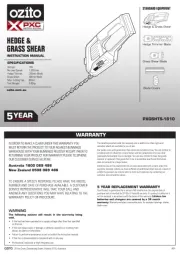
15 Augustus 2025
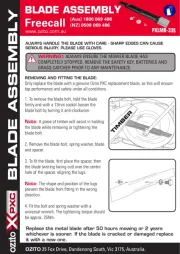
14 Augustus 2025
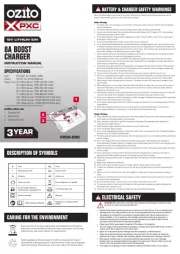
30 Juli 2025
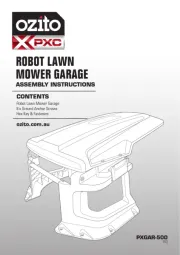
29 Juli 2025
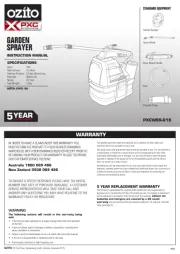
3 Juli 2025
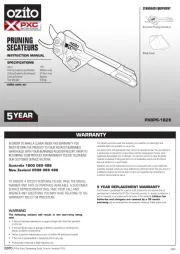
3 Juni 2025

10 December 2024

2 November 2024

8 April 2024

8 April 2024
Handleiding Niet gecategoriseerd
- Ganz
- Siemens
- Hangman
- Nubert
- Sera
- Greemotion
- Laine
- Weltevree
- Logitech
- Scale Computing
- Dataflex
- Natec
- Phase One
- TDK-Lambda
- AquaMAX
Nieuwste handleidingen voor Niet gecategoriseerd

14 September 2025

14 September 2025

13 September 2025

13 September 2025

13 September 2025

13 September 2025

13 September 2025

13 September 2025

13 September 2025

13 September 2025